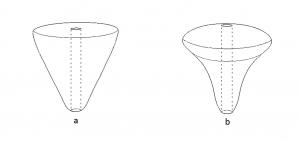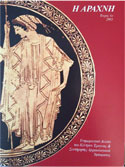Textile tools
Textile production in antiquity was a complex and very time-consuming craft that required specific know-how and a variety of tools. Ancient textile tools, made of clay, stone or bone, are possibly the most important archaeological source regarding ancient textile production, since prehistory and until late antiquity. They are found in archaeological excavations and studied by specialists using specific analytical methods, in order to yield information that is often complementary to this of other sources, such as written sources, iconography, ethnological data and most importantly, the finds of ancient textiles that rarely survive through time due to their organic nature.
Textile tools can be divided into categories depending on the stage of the chain of operation, in which they are used. This way we distinguish tools used in the processing of raw materials, in yarn and textile production, in textile dyes and finally in textile finishing.
The main textile tools used in antiquity continued to be used through time, with varieties in the basic technological conceptions: the thread was spun with the spindle and the fabric was woven on the loom. These are the two main tools with the longest use and an ecumenical presence in every ancient civilisation: the spindle and the loom first appeared during Neolithic times and constituted an essential element of every household until the Industrial revolution, in the 19th century.
Processing of raw material
In this category are included tools, such as the scissors to shear sheep (kouris), sticks to beat the material and separate the fibres and combs for combing wool and linen.
Thread production
Spinning is the operation during which the fibres are twisted in order to produce a continuous and solid thread that can be used on the loom. At earlier times, spinning would have probably been carried out by hand, without instruments. Though the use of tools allow the production of more thread in less time. The most common tools of thread production in ancient Greece were the spindle (atraktos), the distaff (hēlakatē) and the spindle-whorl (sphondylos).
The spindle is a simple, wooden rod, at the bottom of which was inserted the spindle-whorl, a perforated circular weight of clay, stone, bone or wood. In Greece, spinning was carried out approximately in the same way, from prehistory to modern times. It consists in taking some fibres from the distaff, stretching them with the fingers and simultaneously twisting the spindle. With the double movement of the spindle and the fingers, the fibres are being stretched and twisted, thus forming a solid thread, which is wrapped around the spindle.
There are variations of this instrument in every period and culture. So we find the spindle-whorl sometimes at the bottom, sometimes at the top and other times at the middle of the spindle. Moreover, ethnological studies have shown that spinning was performed using different gestures in each society: the spindle, for example, instead of floating in the air, can also rest on the ground, inside a bowl or on the spinner’s thigh and rotate in a supported position.
At the same time, there are also variations in the form of the spindle-whorl, which was made of various materials, such as clay, stone, bone or wood and had different shapes: conical, biconical, cylindrical, spherical or, often in the shape of a fine, circular disk. In certain places spindle-whorls were very simple, while in others they had a nice form, a neat surface and even a decoration with incised, painted or impressed patterns. From prehistoric times, spindle-whorls from Troy are famous for both their quantity and decoration, while those found near the Acropolis of Athens were equally impressive for the same reasons. The weight and diameter of spindle-whorls depended on the desired thickness of the threads.
Moreover, the spindle and spindle-whorl were in some occasions made of precious materials, such as ivory and silver, like the famous “silver hēlakatē” of the Homeric Helen. Spindles are rare finds in Greece, principally because they were made of wood that is rarely preserved. However, two 4th c. BC bone spindles have been discovered in Kerameikos.
The distaff is the wooden, forked rod that accommodates the raw material for spinning. Usually it changes size depending on the raw material. The distaff for wool is shorter than the one for flax and plant fibres in general.
Raw materials, threads and tools were transported and stored in baskets (kalathos, talaros). As they are made of organic materials, they are rarely found in excavations. However, models of 9th c. BC ceramic baskets are exhibited in the Museum of the Agora.
Another textile instrument depicted in ancient iconography is the epinētron, a clay knee protection of semi-cylindrical shape and coarse surface. It is positioned on the spinner’s thigh and used for twisting fibres on its surface in order to make a first, coarse thread that would be later spun with the spindle.
Textile Production
The loom is a technological invention that facilitates the interweave of the warp and the weft in order to produce a cloth. The conception is that one thread system, the warp threads, have to be well taut, in order that the other system, the weft threads can be inserted quickly between the warps. In the eastern Mediterranean, there is archaeological evidence for two types of loom, depending on the period and the culture, the horizontal and the vertical loom.
In Greece, the commonest textile production technique was weaving on the warp-weighted loom (histos orthios). At the same time, however, there were other textile production techniques in use, and each required specific tools.
The warp-weighted loom is a simple construction made of two vertical wooden beams (istopodes or keleontes) stuck in the ground and connected by two other, finer beams. The first one is the modern anti (antion), positioned at the upper side of the loom and holding the cloth. The second one (kairos) is at the centre and divides the warp threads into groups depending on the weave in order to create the shed to insert the weft threads.
The ends of the vertical warp threads were attached to small weights, the loom-weights (laiai) that kept the threads taut so that the wefts could pass between them. The loom-weights were usually made of clay or stone and had several sizes and shapes, imposed by functional or cultural factors, or both. The most common shapes of loom-weights in ancient Greece were the pyramidal, the conical, the trapezoid and the discoid. Loom-weights are a common archaeological find in Greece. As they were always used and stored in sets, they are usually discovered in smaller or larger groups.
The weight of the loom-weights depends on the diameter of the warp threads. The finer the thread, the lighter the loom-weights. At the same time, the width of the loom-weights (namely the distance between on two loom-weights) depends on the desired density of the cloth. The wider the loom-weights, the more open the cloth. The different shapes of loom-weights served different types and qualities of fabrics. Hence, in order to produce a very fine and dense fabric, weavers had to use a light and fine loom-weight, for example a discoid one. In other words, when a large quantity of very light loom-weights is discovered, we can be sure that they were used for the production of very fine fabrics.
It should be noted that both the vertical and the horizontal looms had more parts and tools usually made of wood that are not preserved. Iconography enriches crucially our understanding of these instruments via depictions of looms in Archaic and Classical art. The detailed form and function of the prehistoric looms in Greece and their tools is less clear, since textile tools and production scenes were not depicted in iconography of the Neolithic and Bronze Age.
Finishing
After the weaving took place the last stage of preparation of the cloth for use. In this stage, the fullers (knapheis) had the first role and carried out a series of activities and treatments in specific workshops and using a variety of tools. After fabrics were washed and fulled with the feet to soften and felt the fibres, they were left to dry and treated again in various ways. Fullers were also responsible for pleating fabrics using a special press (ipos) and create the permanent pleats depicted in ancient iconography.
Finally, the decorative techniques used after weaving, such as embroidery, also required a set of tools, like varieties of needles of different sizes (belonis, rhaphis), also necessary for sewing.





